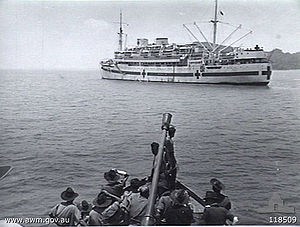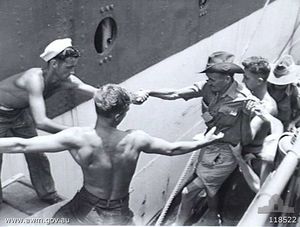Wanganella
| |
This article needs additional citations for verification. Please help improve this article by adding reliable references. Unsourced material may be challenged and removed. (May 2009) |
 Australian ex-POWs being transferred to the hospital ship Wanganella two days after their liberation from Batu Lintang camp, Kuching, Sarawak, on the island of Borneo in September 1945 | |
| Career (Australia) | |
|---|---|
| Owner: | Huddart Parker |
| Builder: | Harland & Wolff, Belfast |
| Launched: | 17 December 1929 |
| In service: | 12 January 1933 |
| Out of service: | 1963 |
| Reclassified: |
Passenger liner (1933-1941, 1946-1963) Hospital ship (1941-1946) Floating hostel (1963-1970) |
| Homeport: | Port of Melbourne |
| Fate: | Used as hostel for construction workers from 1963 to 1970. Towed to Taiwan in April 1970 and scrapped |
| General characteristics | |
| Displacement: |
9,576 gross registered tons 5,625 net tons |
| Length: | 144.5 metres (474 ft) |
| Beam: | 19.5 metres (64 ft) |
| Draught: | 7.6 metres (25 ft) |
| Propulsion: | Two 4-stroke Burmeister & Wain 8-cylinder diesels (6,750 bhp) |
| Speed: | 17 knots (20 mph; 31 km/h) |
| Capacity: | 304 First Class, 104 Second Class |
| Crew: | 160 |
TSMV Wanganella was an Australian-registered merchant vessel constructed by the Harland and Wolff shipyards and entering service as a trans-Tasman passenger liner in 1933.
Acquired and operated by Huddart Parker after the original sale to The Royal Mail Group fell through, Wanganella sailed between Auckland and Wellington in New Zealand, and Sydney and Melbourne in Australia until 1941, when the ship was converted into a hospital ship. As Australian Hospital Ship (AHS) Wanganella, the ship operated in support of Australian forces until 1946, when she was returned to her civilian operator.
During the 1950s and 1960s, Wanganella was affected by several incidents of industrial action by wharf labourers. The increase in travel by air made operating the ship less viable, but before the ship was due to be scrapped in 1963, she was acquired and moored in Doubtful Sound, New Zealand, and used as a hostel for construction workers building the Manapouri Power Station until 1970. In April 1970, a tug towed Wanganella to Hong Kong, then later Taiwan, where she was scrapped.
Contents
Construction
Wanganella was built at the Harland and Wolff shipyards in Belfast, Northern Ireland and launched on 17 December 1929. She was originally christened Achimota, and destined for use as a mail and passenger liner for the West African trade. The commissioning owners, The Royal Mail Group, suffered financial trouble as a result of the Great Depression, and Harland & Wolff sold Achimota to defray building expenses. The vessel was bought by the Melbourne-based Australian shipping company Huddart Parker at a bargain-basement price in September 1932, and commenced regular service on 12 January 1933.
Operational history
Pre-World War II
Renamed Wanganella, the ship operated as a top-rated trans-Tasman passenger liner, with accommodation for 304 First Class and 104 Second Class passengers. She primarily sailed between the cities of Auckland and Wellington in New Zealand, and Sydney and Melbourne in Australia, making the Tasman Sea crossing in three and a half days.
On 28 December 1937, she collided with a trawler off the coast of New South Wales.
On 19 June 1940 she assisted with the rescue of passengers from the RMS Niagara, after the latter hit a mine and sank off the coast of Auckland.
Hospital ship
During World War II, Wanganella was converted to serve as an Australian Hospital Ship (AHS). Between 19 May 1941 and 1946, AHS Wanganella carried wounded and sick evacuees from the Middle East, New Guinea, Solomon Islands, Borneo and the South Pacific, travelling over 251,011 nautical miles (464,872 km) and transporting 13,385 wounded.[1]
A recently-liberated soldier from Batu Lintang camp, Kuching, Sarawak wrote of her:
My first real sight of the hospital ship occurred at a range of well over a mile ... Distances and sizes of things at sea can be very deceptive ... [and] I realised she was far bigger in all respects than I had imagined. Wanganella, for such was her magic name, rode quietly at anchor unperturbed by wind or tide, unreal, dazzling white, clinically neat, a heavenly ship waiting patiently as a lover to receive us. ... I swayed with the motion of the MTB. My liberator Massey laughed at my weakness but enthused, 'This is one hell of a good ship. You'll be alright now cobber!' It seemed a contradiction interms to call Wanganella 'a hell of a ship'; to me she appeared as a vessel from another world, but I understood his concern to reassure me that indeed there was now hope of a future for us all. The port side of the ship towered high above us. I viewed with dismay the formidable rank of steps leading from the launch to the main deck. ... The slow energy sapping climb began. Each patient, for that was what we had become; was escorted by male Australian nurses. They were taking good care, that even as we had been snatched from under the Japanese heel, we should not fall now, and be claimed by the sea. ... After an eternity of endeavour, advancing one step at a time, one by one we reached the deck. Behind me a voice avowed 'I would not like to have to do that all over again.' It was Slim Landers: I was not sure whether he meant the climb up the gangway or the three and a half years at Batu Lintang."—[2]
Post-war
On her maiden voyage after the war, Wanganella had a narrow escape when she ran aground on Barrett Reef (later to claim Wahine with 51 lives lost) at the entrance to Wellington Harbour in New Zealand. On 19 January 1947, while making its first trans-Tasman voyage after the war, Wanganella struck Barrett Reef just before midnight and stuck fast. The weather conditions were unusually benign, and remained so for the 18 days the ship spent on the reef. (Such benign weather is still known in Wellington as "Wanganella weather"). No-one was injured, and the passengers were taken off the ship the morning after the accident. The damage she incurred put her out of action for twenty-two months, mainly as a result of industrial action while she was laid-up in a floating dock for repairs.
Wanganella was caught up again in industrial action; this time in the 1951 New Zealand waterfront dispute. This 151-day-long industrial battle between the employers and the watersiders in New Zealand began when watersiders refused to work overtime. The New Zealand Government, hand-in-glove with the employers, was determined to smash the union and introduced Emergency Regulations. The army was brought in to work the wharves. Wanganella became involved in smuggling money and manpower between Australia and New Zealand, with her Australian crew carrying thousands of pounds to New Zealand from various unions in Australia, in support of their New Zealand comrades.
In about 1960, Wanganella was acquired by the scrap metal dealer Albert G Sims, and was sent to Sigapore for breaking up as scrap. However, there was a drop in scrap metal prices, and the ship returned to service on the Sydney to Auckland run, under the control of the Hong Kong based Hang Fung Shipping and Trading Company.
Hostel ship
During the 1950s and 1960s, the expansion of civilian air travel made trans-Tasman shipping obsolete. In 1963, shortly before the ship was due to be scrapped, engineers working on the construction of the Manapouri Power Station in New Zealand acquired Wanganella. Between 1963 and 1970, Wanganella was moored in Doubtful Sound to be used as a hostel for workers building the tailrace tunnel, and the Wilmot Pass access road. Wanganella was sold for scrap in 1970, and was towed to Hong Kong, then Taiwan. The cove in which Wanganella was moored and the stream that supplied the water to the liner are now gazetted as Wanganella Cove and Wanganella Stream.
Notes
References
- Ooi, Keat Gin (1998) Japanese Empire in the Tropics: Selected Documents and Reports of the Japanese Period in Sarawak, Northwest Borneo, 1941-1945 Ohio University Center for International Studies, Monographs in International Studies, SE Asia Series 101 (2 vols) ISBN 0-89680-199-3
- Smith, A. E. (May 1992) [1991]. Three Minutes of Time - the torpedoing of the Australian Hospital Ship Centaur (Second Printing ed.). Miami: Tasman Press. p. 19. ISBN 0-646-07631-0.

